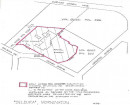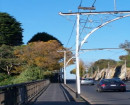QUEENSTOWN GOVERNMENT BATTERY
75 SMITHS GULLY ROAD SMITHS GULLY, NILLUMBIK SHIRE
-
Add to tour
You must log in to do that.
-
Share
-
Shortlist place
You must log in to do that.
- Download report
Statement of Significance
This record has minimal details. Please look to the right-hand-side bar for any further details about this record.
-
-
QUEENSTOWN GOVERNMENT BATTERY - History
Contextual History:History of Place:
Heritage Inventory History of Site:
From 1897 the Victorian governmnet provided assistance to quartz gold prospectors through the installation and operation of small quartz crushing facilities (known as government or State batteries) in localities where no privately-owned batter was available for public use. Their number peaked between the wars, with a maximum of 33 in operation. Government crushing facilities were quite small concerns, at first being equipped with only three heads of stamps, rising in 1904 to a standard of five head, The batteries were originally powered by steam, but producer gas, oil and electricity eventually replaced steam-power.
The operation of government batteries was never economical. For example, the Mines Department's annual report of 1910 shows that, between 1897 to 1910, £52,717 was spent of the erection, operation and maintenance of 24 plants, with only £7,905 incoming for the crushing of 36,074 tons of stone. In order to reduce expenditure, the Mines Department ecouraged the establishment of local committees to manage and operate the batteries. Small cyaniding plants were installed at some of the batteries, in an effort to raise additional income by processing battery tailings.
At the end of the Second World War, the numbers of government batteries had declined and by the 1980s, the number of government batteries was reduced to the point that they were all managed by one man. He retired in the mid-1980s and the batteries have seen little operation since. At present there are six substantially intact former State Batteries in Victoria: Maldon, Bright, Mount Egerton, Creswick, Rutherglen, and Wedderburn.
The Queenstown Government Battery was opened soon after the First World War. Like most government batteries the facility was used intermittently. The weatherboard battery house was burn down in a bushfire in 1962 and the machinery was subsequently removed to be used elsewhere.Heritage Inventory Description
QUEENSTOWN GOVERNMENT BATTERY - Heritage Inventory Description
The remains of the Queenstown Government Battery are located at the commencement of the Smith's Gully Walking Track.
Heritage Inventory Signficance: Historical significance: the Queenstown Government Battery was an integral part of the area's quartz mining industry during the early twentieth century. Scientific significance: sufficient relics survive to provide a general impression of what took place on the site. Social value: the heritage values of the place in enhanced when viewed as part of a precinct, which contains the Black Cameron mine, alluvial workings along Smith's Gully, and Queenstown Cemetery.
Heritage Inventory Key Components: Battery : timber mortar blocks (5-head battery), concrete mounting blocks and floor. IN the creek below the battery is a concrete weir. The foundations are located on the east side of the walking track. Cyanide works: small dumps of battery sand, one galvanised iron vat, and a poison tank. The relics are located on the west side of the track.
-
-
-
-
-
SMITHS GULLY GOLD WORKINGS
 Victorian Heritage Inventory
Victorian Heritage Inventory -
BULWIDJ GOLD MINE SHAFT
 Victorian Heritage Inventory
Victorian Heritage Inventory -
Lenkunya
 National Trust
National Trust
-
-







